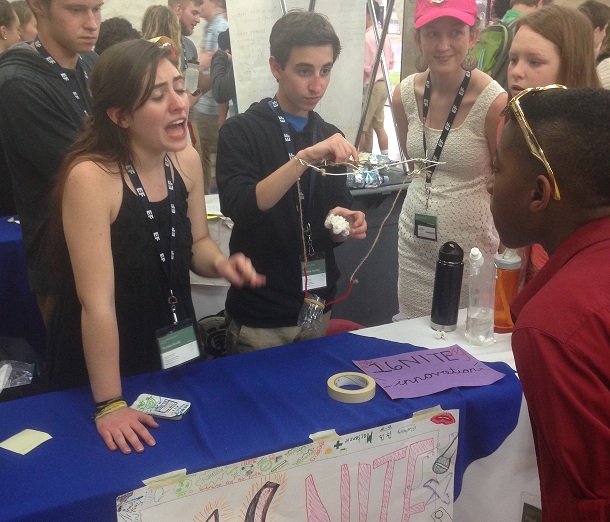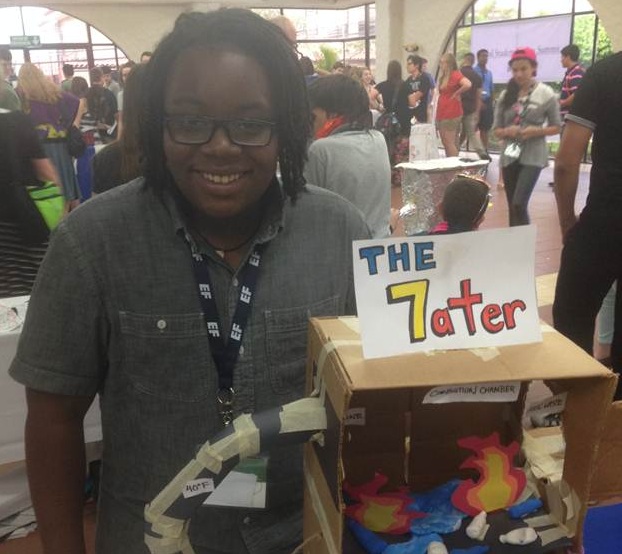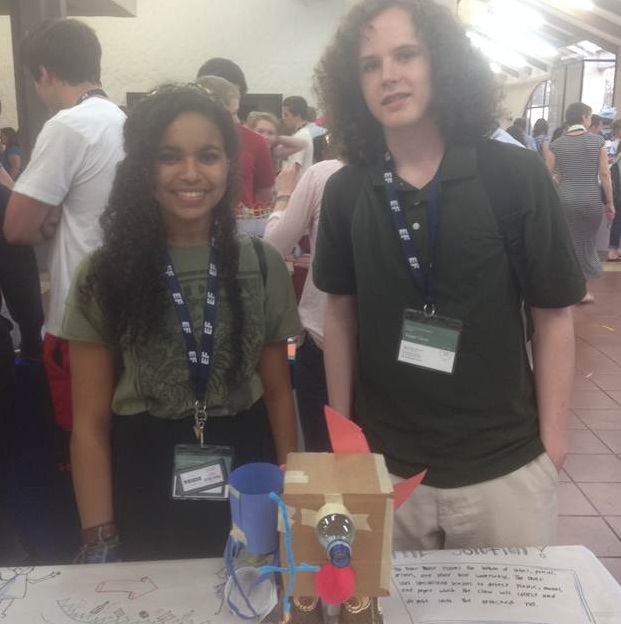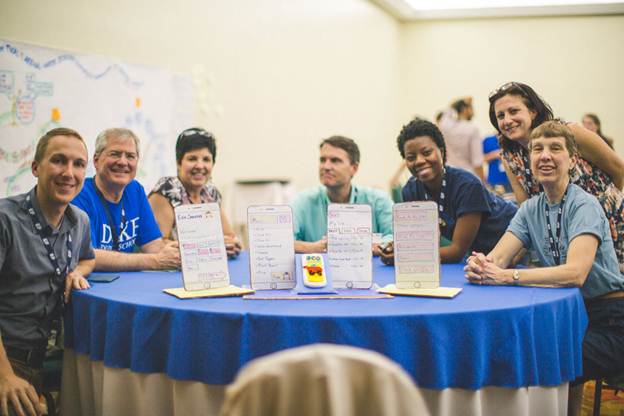The culmination of every EF Global Leadership Summit is the Innovation Village. Picture a science fair that surpasses the energy of a stock exchange trading floor and is filled with students who naturally get confused when they hear the word “impossible” being used. That is the Innovation Village, and it is without a doubt one of the most inspiring parts of the Summit experience. Over the course of a two-day leadership conference, hundreds of students and teachers collaboratively design and present inventive, out-of-the-box solutions to pressing global issues. These projects truly embody the Design Thinking process, reflecting creativity, user-centered empathy and a nothing-is-impossible attitude.
Take a look at some of our favorite environmental solutions from the 2015 Costa Rica Summit’s Innovation Village. We also couldn’t help but add a “potential” outcome for each solution. After all, at the Summit the word impossible doesn’t exist:

Issue: Food waste
Solution: In an effort to decrease food waste, this team developed a kitchen tool that could be used to measure the exact amount of food a person would need to eat for every meal. Their solution didn’t stop there. If someone still happened to cook more than they should have, the group also prototyped a refrigerated lunch box that would store excess food, and be picked up and delivered to local food shelters.
Potential Outcome: Families practice healthier eating habits and dinner leftovers find a home better than the back of your fridge, also known as the “cold abyss.”

Issue: Plastic bags
Solution: Unhappy with the number of plastic bags used in shopping centers, group 26 developed a solution called the Urth Bag – because “Improving the Earth starts with U.” The group realized how difficult it would be to change people’s attitudes about using plastic bags; while re-usable bags are already widely offered at malls and grocery stores, they’re still far less prevalent than traditional plastic bags. So they decided instead to design compostable, environmentally friendly bags that would be distributed to shopping centers in place of plastic. Consumers would still use the bags as they always have, but the bags would either be composted or would naturally decompose when thrown out. The group essentially shifted the dialogue away from individual consumer attitudes, focusing instead on changing the opinions and attitudes of more easily identified retail companies and businesses.
Potential Outcome: Corporate social responsibility becomes more transparent and directly connects with consumer purchases. And shoppers no longer have to feel guilty about double bagging heavy grocery bags.

Issue: Sea turtle poaching
Solution: While on tour before attending the leadership conference, the students on team 16 visited a sea turtle nesting ground. There, they learned of the huge threat that poaching poses to sea turtle nesting in Tortuguero, and that the Costa Rican government has a hard time protecting these nests and identifying poachers. To address this the group re-engineered the nesting ground to safeguard the eggs from poachers. Built into this was an alert system that would let officials know when someone had tampered with the eggs while simultaneously taking the culprit’s photo. This photo could then be shared with law enforcement through an app that would help streamline the poacher identification process.
Potential Outcome: Poachers can’t trespass on the nesting grounds without having their picture taken by law enforcement. Sea turtles thrive in Tortuguero and the threat of poachers is eliminated.

Issue: Littering
Solution: Group 13 wanted to tackle the issue of littering, but realized while designing their solution that any human resources they designated specifically to solving this issue would be expensive and therefore limited. With this in mind, they developed a solar-paneled robot that would roam parks and vacuum up trash. When full it was programmed to return to a pick-up location, where it could be emptied and sent back out.
Potential Outcome: If you litter this robot is going to follow you around…Or you could not litter and this robot will leave you alone.

Issue: Garbage vs. Recycling
Solution: Have you ever thrown something in the garbage can even though it should have gone into recycling, just because? Realizing that this was a pretty common occurrence, this group developed a smart trashcan – one that could distinguish between the types of materials being thrown away. It would sort recyclables to be picked up at a later date, while normal trash would go into a combustion chamber.
Potential Outcome: Recycling becomes a widespread practice across all homes and organizations in the United States.

Issue: Clean Drinking Water
Solution: Over 700 million people worldwide lack access to clean, safe drinking water. Moreover, purification systems can be bulky and difficult to transport. In an effort to remedy that, these students designed a T-shirt that is coupled as a water purifier. The water could be poured into the shirt’s water-tight bag, which would have a carbon-based purification system built into it. Once purified, the drinkable water would filter into a camel-back pouch for the wearer.
Potential Outcome: This new T-shirt helps provide clean drinking water all over the world, and sets a new fashion trend for outdoor athletes everywhere.

Issue: Water Pollution
Solution: These students noticed a huge problem with water pollution and debris in a local river that runs through their town. So they prototyped the River Rover: a robot that floats along the bottom of lakes, ponds, rivers and other local waterways. It uses specialized sensors to detect plastic, metal and paper – any material that doesn’t belong in that environment – which is then picked up by a claw built into the rover, and deposited into its attached net.
Potential Outcome: Fisherman may mistake the River Rover for the “big one” but they’ll soon realize that it is, in fact, a robot keeping their local waters clean and providing a new healthy environment for fish.

Issue: Water pollution caused by waste runoff
Solution: In the Empathy stage of Design Thinking, this group interviewed a student who grew up on a farm in the Midwest. They identified that water and soil contamination caused by animal waste runoff from nearby farms was creating a major issue in the student’s local community. To tackle this, the group decided to model a new type of farm. Animal pens would drain off into a purification system where waste would be separated from water. It could then be turned into organic fertilizer while purified water was channeled back into the environment.
Potential Outcome: Nationwide, farming communities implement an organic fertilizing strategy that helps local agricultural businesses flourish while making community soil and water safer.

Issue: Environmentally friendly transportation
Solution: Working off of a point of view statement “Eliza needs a way to travel by plane, but
doesn’t want to waste energy or pollute the air,” this group designed a green airplane. Tackling everything from the fuel used to power the plane to the waste created while on board, they thought through every aspect of the travel experience, and how to make it eco-friendly.
Potential Outcome: The sky may be blue, but with these students calling the shots the airline industry’s future just got a little bit greener.

Issue: Identifying green food options
Solution: As part of the Summit’s professional learning track, teachers attending the conference in Costa Rica participated in the design thinking process as well. This teacher group wanted to figure out an easier way of making green choices while grocery shopping. They felt that it’s often difficult while shopping to distinguish food that is locally produced, organic or fair trade from less environmentally conscious options. So they prototyped an app that would identify food in supermarkets in a user’s neighborhood based on a variety of factors: where it was produced, how it was produced and price, for instance. The user could then have the best options from their search be collected from grocery stores in the area and delivered to their home.
Potential Outcome: Tech giants lineup to buy a mobile grocery shopping application from seven teachers who gathered in Costa Rica and designed a solution for making grocery shopping more environmentally focused.
GLOBAL LEADERSHIP SUMMITS
These extraordinary events combine educational tours and a two–day leadership conference, tackling significant global issues in places where they come to life. You and your students learn from experts such as Al Gore, Jane Goodall and Sir Ken Robinson, and U.S. and local students work together to design and present their own solutions to the issue. Each Summit empowers your students today to start becoming the leaders of tomorrow. Upcoming Summits will tackle Global Citizenship in a Changing World in Peru and the Future of Food in Italy.
Related articles
